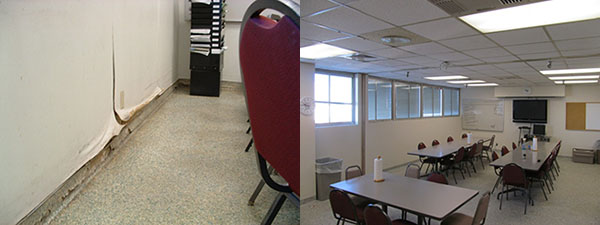Pantex Blog
Building Makeovers - Vehicle Maintenance Facility
Operations began at the Pantex Plant in 1942, so it's no surprise many of the almost 650 buildings are in need of repair, renovations or refurbishment. Many of the issues with facilities were identified in the Quality of Life list that was developed after the Safety Culture Surveys in 2010 and 2011. Here’s an update on the Vehicle Maintenance Facility (VMF)at Pantex.
Although the VMF is a few decades newer than its predecessors, it has been in use since the 1980s – more than 30 years with no upgrades. In one break room, wallpaper was peeling and everything in the area seemed to stay damp. The kitchen area was completely overhauled with new cabinets, a sink and an oven. The mechanics break room was completely gutted and new dry wall was installed and painted.
Contractors also re-sealed the windows and replaced the floor. In addition, new filing cabinets were installed to honor requests to expand the storage in the break room.
The restrooms were equally problematic with dirt, stains and leakage. All the restrooms and shower facilities have been replaced completely. New flooring, dry wall, tile, lavatories, and plumbing were installed. The windows were re-sealed and some lockers were replaced.
Finally, an upstairs office was converted to a main conference room and smaller offices including new tile floor, painting and new cubicles. All the flooring, damaged or dirty ceiling tiles, and HVAC vents in the first and second levels were replaced.
The transformation was completed over seven months. The repaired areas look like new, and only products designed for longevity were used in the renovation.
VMF Men's Shower Before and After

VMF Mechanic's Break Room Before and After

VMF Yard Group's Break Room Before and After

GWI Plan Ensures Focused, Consistent Approach to Improvements
Three years ago as part of the Quality of Life initiative, Y12 Production developed a standardized checklist for evaluating livability in the production facilities from criteria used by restaurants, schools and other public facilities. This systematic approach for renovations, using a standardized evaluation form, helped ensure equality across the facilities. Now, this evaluation method has been adopted enterprise wide and incorporated into the CNS General Workplace Improvement (GWI) Program Plan issued in January.
The intent of the GWI program is to identify, prioritize and execute activities that will improve the work environments at Pantex and Y12. The plan provides guidance for prioritization and execution of GWI projects and will be updated annually to define and communicate planned projects.
GWI Program Manager Jim Reilly said, “GWI investments provide basic human needs and help maintain or improve personnel safety. The GWI plan will ensure a focused and consistent approach to improving the workplace environments at both sites.”
GWI projects will concentrate on common areas, such as breakrooms, office areas, lunchrooms, restrooms, change houses, lobbies and parking lots, with improvements to lighting, HVAC systems, plumbing, carpentry, roof repairs, painting and walking surfaces. Renovations will be prioritized based on safety risk, severity of existing conditions, number of people affected, as well as future use.
In FY 2014, $9.3 million was invested in GWI, and both sites combined addressed nearly 500 GWI-related projects, which included direct employee concerns identified through the Pantex Safety Culture Advocates and the Y12 Employee-Driven Safety Campaign.
“The success of the GWI program is dependent on feedback from employees to identify scope and evaluate the effectiveness of completed improvement activities,” Reilly said. Currently, Y12 building managers and Atomic Trades and Labor Council safety representatives are reevaluating conditions in facility common areas by performing walk downs together and updating the 2012 ratings. A similar analysis is being performed at Pantex.
After the data are collected, the information from both sites will be evaluated and ranked by the Safety Culture Monitoring Panel to identify the highest-priority projects for the next fiscal year.
In FY 2015, several GWI projects are underway. At Pantex, six restroom/shower areas in Buildings 12-5, 12-5C and 12-6 are being refurbished, and the hot water system in Building 12-103, one of the plant’s primary change areas, is being replaced. Similarly, at Y12, the Post 8 pedestrian checkpoint has been enclosed to provide a climate-controlled area for personnel processing through the area. A second Y12 project involves reconfiguring the Building 9119 auditorium to provide a modern, large group meeting area inside the protected area.
“CNS is committed to investing in the GWI initiative to improve workplace conditions. The poor conditions in some areas that resulted from years of deferred maintenance, as well as everyday use, do not provide optimal working conditions. Such conditions lower morale and degrade the safety conscious work environment,” said Paul Wasilko, CNS Safety Culture program manager.
“Our goal is to strengthen our safety culture by addressing the needed improvements. These conditions cannot all be fixed overnight — but we now have a process in place to identify and prioritize the needed improvements.”
Energy Contracts Help Sites Achieve Savings, Sustainability

Typical mortgage loans allow borrowers to purchase a home without paying the full cost upfront. In a similar manner, energy savings performance contracts, or ESPCs, allow Consolidated Nuclear Security, LLC, to complete projects at Pantex and Y12 that improve energy efficiency and support infrastructure renewal and reliability without upfront capital.
During the past few years, the National Nuclear Security Administration Production Office has partnered with two energy service companies on ESPCs at Pantex and Y12 as part of an enterprise-wide initiative to improve energy efficiency and revitalize site infrastructure.
Senior Director of Infrastructure and Projects Management Dan Glenn said, “The energy service company puts up the capital to do the work, and we pay them back through the energy savings gained over the term of the contract.”
At Pantex, an ESPC with Siemens Government Technologies Inc. has enabled the plant to harness the power of wind energy with the installation of five 2.3megawatt wind turbines capable of producing approximately 47 million kilowatt-hours of electricity annually.
During installation of the wind turbines, Infrastructure and Projects Management worked with Pantex Engineering to address a concern about possible voltage fluctuations affecting the plant’s sensitive equipment. The solution was to install a power quality meter to monitor the specific output of the wind farm. The 426foottall turbines can generate enough energy cost-savings to pay for the project and later provide additional cost savings directly to Pantex. In the month of May, the wind farm produced 4,022,647 kWh, which was 66% of the plant’s total energy consumption.
At Y12, the ESPC projects, managed by Johnson Controls, Inc., are having noticeable impact on the utility infrastructure, as well as the site’s energy efficiency.
“We wouldn’t have the budget to do this work at Y12 without an ESPC. More money becomes available because it is tied to energy savings. We try to leverage all funding opportunities to improve the infrastructure to make it more reliable and reduce the maintenance needs of the site,” Glenn said.
Currently, there are five main projects at different stages of progress, including the chiller plant upgrade, steam system decentralization, lighting upgrades, a new compressed air facility and steam system repairs. The upfront capital for these projects is funded by JCI; however, Y12 is responsible for support costs, including activities such as lock out/tag out, utility surveys and engineering drawing review.
Providing support funding and coordinating activities to lessen the impact to mission work and schedule are some of the challenges that come with ESPCs.
“These projects improve plant reliability, operational efficiency and infrastructure, and eliminate a significant amount of deferred maintenance. We invest our funds into the support costs for the ESPCs because we know of the bigger benefit to the site,” Glenn said.
“Improving energy efficiency and revitalizing the infrastructure is an enterprise-wide initiative, and we’ll continue to leverage ESPCs to help achieve our sustainability goal.”
Staying Active - for Life
More than 800 CNS employees participated in the Active for Life Challenge April 1–June 3. This 10-week program encourages people to be more active and eat healthier foods on a regular basis.
“It was terrific to see people out walking around the plant, in the gyms in town or participating in group activities during lunch,” Sherry Philyaw, Pantex Active for Life captain, said. “My favorite part was seeing people getting active and taking charge of their own health.”
Karen Lacey, LiveWise dietitian and Y-12 Active for Life captain, agreed. “I loved seeing our teams participating at the Secret City 5K and Relay for Life. Our multiple onsite challenges (longest plank, most pushups) encouraged some great competiveness between us and Pantex.”
The overall top CNS team was TEAM V, located at Pantex. This Active for Life team truly embodied the CNS OneTeam vision. Pantexan Marc Brooks explained, “While six of us are here at Pantex, one of your own (Eric White, who works at Pantex about 25 percent), was also a member of TEAM V. So, the top CNS team was a joint effort of Pantex and Y12 after all!”
While Pantex and Y12 didn’t place in the top category for the multi-lab challenge, CNS employees can be proud.
Lacey said, “CNS participants averaged over 46 minutes per day, which meets and exceeds recommendations for overall health and minimizing risk of chronic disease, and far exceeds national averages for activity. It thrills me to see these numbers!”
Lacey and Philyaw are already planning for next year’s campaign.

Allison Roberts was one of the more than 800 CNS employees who participated in Active for Life
Education on Aisle Nine

Grocery shopping. Some people carefully plan a weekly menu and painstakingly make a list in an attempt to stick to their budget. Others dread the task so much they just show up at the store hungry, throw items in the cart and go home hoping to make a meal of their basket full of random purchases.
Regardless of which category they fit in, several Pantexans recently turned this mundane weekly task into a fun educational event.
The employees and some family members visited two local grocery stores for healthy shopping tours. The tours, hosted by Market Street United and Natural Grocers, were part of the Active for Life Challenge, a 10-week American Cancer Society program to encourage employees to be more active and eat healthier foods.
At Natural Grocers, the store manager and employees provided an aisle-by-aisle overview of many healthy food products and supplements. They talked about food philosophy and standards. The produce manager even cut a blood orange for participants to taste. Attendees also took home a new product sample and some literature from the store’s nutrition library.
Kelly Delgado-Goudschaal, manager of Pantex Supply Chain Management Transformation and Strategic Initiatives, was impressed by the store’s advice to gradually convert to a healthier lifestyle.
“The store manager encouraged us to make small changes instead of jumping off a cliff into health eating,” Delgado-Goudschaal said. “The prices were also not as expensive as I expected.”
She made the tour a family affair by bringing her wife and three daughters along. The kids said the samples offered during the tour were “not as gross as they expected”.
At Market Street United, a certified dietician offered a two-hour Easy Diabetes Shopping store tour designed to help diabetics make healthier shopping decisions.
Pantex Engineer Sharon Smith said, “The tour was fantastic! We learned how to use the special number on the price stickers to help us choose the healthier items”.
Those who couldn’t attend a store tour were encouraged to complete a grocery store scavenger hunt to learn about product placement and labeling.

